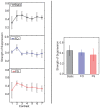Temporal analysis of image-rivalry suppression
- PMID: 23049797
- PMCID: PMC3458036
- DOI: 10.1371/journal.pone.0045407
Temporal analysis of image-rivalry suppression
Abstract
During binocular rivalry, perception alternates between two different images presented one to each eye. At any moment, one image is visible, dominant, while the other is invisible, suppressed. Alternations in perception during rivalry could involve competition between eyes, eye-rivalry, or between images, image-rivalry, or both. We measured response criteria, sensitivities, and thresholds to brief contrast increments to one of the rival stimuli in conventional rivalry displays and in a display in which the rival stimuli swapped between the eyes every 333 ms-swap rivalry-that necessarily involves image rivalry. We compared the sensitivity and threshold measures in dominance and suppression to assess the strength of suppression. We found that response criteria are essentially the same during dominance and suppression for the two sorts of rivalry. Critically, we found that swap-rivalry suppression is weak after a swap and strengthens throughout the swap interval. We propose that image rivalry is responsible for weak initial suppression immediately after a swap and that eye rivalry is responsible for the stronger suppression that comes later.
Conflict of interest statement
Figures






Similar articles
-
Probing visual consciousness: rivalry between eyes and images.J Vis. 2008 Aug 5;8(11):2.1-13. doi: 10.1167/8.11.2. J Vis. 2008. PMID: 18831596
-
Detecting contrast changes in invisible patterns during binocular rivalry.Vision Res. 2010 Nov 23;50(23):2421-9. doi: 10.1016/j.visres.2010.09.009. Epub 2010 Sep 19. Vision Res. 2010. PMID: 20858513 Free PMC article.
-
The role of voluntary and involuntary attention in selecting perceptual dominance during binocular rivalry.Perception. 2007;36(2):288-98. doi: 10.1068/p5494. Perception. 2007. PMID: 17402669
-
How does binocular rivalry emerge from cortical mechanisms of 3-D vision?Vision Res. 2008 Sep;48(21):2232-50. doi: 10.1016/j.visres.2008.06.024. Epub 2008 Aug 13. Vision Res. 2008. PMID: 18640145 Review.
-
Seeing the invisible: the scope and limits of unconscious processing in binocular rivalry.Prog Neurobiol. 2009 Apr;87(4):195-211. doi: 10.1016/j.pneurobio.2008.09.002. Epub 2008 Sep 7. Prog Neurobiol. 2009. PMID: 18824061 Free PMC article. Review.
Cited by
-
Stimulus rivalry and binocular rivalry share a common neural substrate.J Vis. 2018 Sep 4;18(9):18. doi: 10.1167/18.9.18. J Vis. 2018. PMID: 30372752 Free PMC article.
-
A monocular contribution to stimulus rivalry.Proc Natl Acad Sci U S A. 2013 May 21;110(21):8337-44. doi: 10.1073/pnas.1305393110. Epub 2013 Apr 22. Proc Natl Acad Sci U S A. 2013. PMID: 23610414 Free PMC article. Clinical Trial.
-
Neural Dynamics during Binocular Rivalry: Indications from Human Lateral Geniculate Nucleus.eNeuro. 2023 Jan 13;10(1):ENEURO.0470-22.2022. doi: 10.1523/ENEURO.0470-22.2022. Print 2023 Jan. eNeuro. 2023. PMID: 36609303 Free PMC article.
References
-
- Baker DH (2010) Visual consciousness: The binocular rivalry explosion. Current Biology 20: R644–R646. - PubMed
-
- Campbell FW, Howell ER (1972) Monocular alternation: A method for the investigation of pattern vision. Journal of Physiology 225: 19P–21P. - PubMed
-
- Logothetis NK, Leopold DA, Sheinberg DL (1996) What is rivalling during binocular rivalry? Nature 380: 621–624. - PubMed
-
- Naber M, Gruenhage G, Einhauser W (2010) Tri-stable stimuli reveal interactions among subsequent percepts: Rivalry is biased by perceptual history. Vision Research 50: 818–828. - PubMed
-
- Necker LA (1832) Observations on some remarkable Optical Phenomena seen in Switzerland; and on an Optical Phenomenon which occurs on viewing a Figure of a Crystal or geometrical Solid. The London and Edinburgh Philosophical Magazine and Journal of Science 1: 329–337.
MeSH terms
LinkOut - more resources
Full Text Sources

